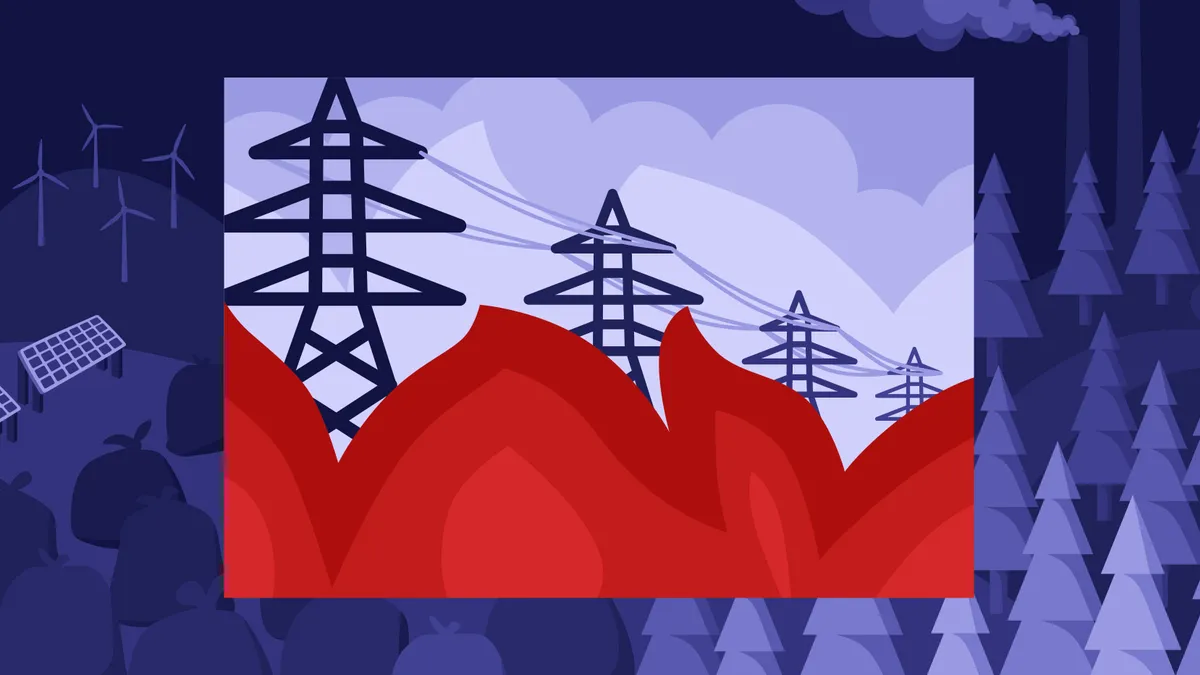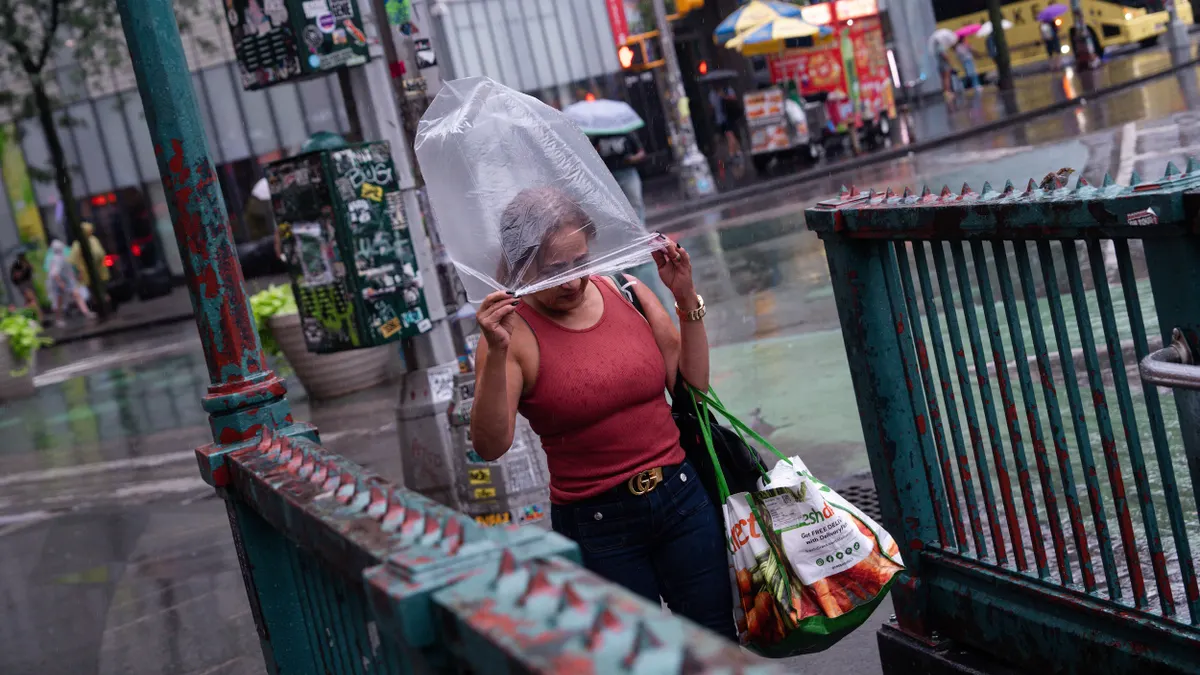This article is part of a series on the way the utility and waste and recycling industries are accounting for climate change.
In 2012, the California Public Utilities Commission (CPUC) adopted a suite of regulations to reduce the fire hazards posed by utility powerlines.
Five years prior, the strong, dry Santa Ana winds that periodically sweep through Southern California caused dozens of fires, killing 17 people and requiring hundreds of thousands of others to be evacuated. Many of the fires were reported to have been caused by powerlines, prompting state regulators to order investor-owned utilities in Southern California to craft fire prevention plans.
But the regulations did not apply to utilities in Northern California. Instead, the CPUC ordered them to carry out assessments of the fire risk in their service territories and develop fire prevention plans only if they met a specific set of weather-related criteria. Unlike Southern California, the decision reasoned, it wasn’t certain that Northern California utilities would even need fire prevention plans.
Eight years later, the state's utility sector is facing a very different reality. In early 2019, PG&E filed for Chapter 11 bankruptcy after fires caused by its powerlines burned hundreds of thousands of acres in Northern California and led to more than 100 deaths. It paid out $25.5 billion to resolve its fire-related liabilities, and expects to spend $11.7 billion on strategies to mitigate wildfire risk between 2019 and 2022, according to the CDP filing that it submitted this year — in 2019, it projected spending up to $2.8 billion on programs for that year. And now, PG&E’s equipment is once again the focus of a Northern California wildfire that the utility thinks could cause it significant liability.
Multiple factors, including equipment failure, led to the Northern California wildfires. But climate change played "a material role," John MacWilliams, senior fellow at Columbia University’s Center on Global Energy Policy, said in testimony presented to a House of Representatives joint hearing on the impact of wildfires on the power sector, in January.
Research indicates that a changing climate has reduced autumn rains and increased winds and daily maximum temperatures, creating "tinderbox conditions" in the western U.S.; one estimate suggests that climate change has caused an extra 4.2 million hectares of wildfire damage in the region since the 1980s, according to MacWilliams’ testimony.
And wildfire risk exposure isn’t limited to utilities in California, the testimony noted — many parts of the country, especially in the Southeast and Northwest — are likely to face increasing wildfire risk. As a result, although no other utility to date has been financially impacted by wildfires the way PG&E has, experts caution that utilities could face increasing risks and costs.
"I think there’s a lot of other utilities that should be concerned about this," Seth Hilton, partner at Stoel Rives, said, adding, "whether or not that risk has manifested yet, utilities and regulators are going to be concerned about this — they’re going to want to try and get ahead of this before they spark a major wildfire and are facing significant financial impacts."
Utilities in Oregon, Arizona, Colorado grappling with fire risk
Wildfires pose a financial threat to the utility sector since in most states, utilities can be held liable for fires caused by their powerlines if they are found to have operated their system "imprudently," and damages are likely to amount to billions of dollars — enough to drive a utility into bankruptcy, MacWillliams noted.
"In either case, climate-change-driven wildfire activity will increase costs to utility-sector stakeholders, including investor-owned utilities, state and local governments, ratepayers, and taxpayers. These increased costs will in turn place financial stress on utility companies and crowd out essential investment in renewable energy and grid upgrades," MacWilliams said in his testimony.
"[I] expect that Oregon regulators – and lawmakers – will be quite active in scrutinizing both wildfire causes and mitigation measures. The role of utilities will undoubtedly be a part of those discussions."

Derek Green
Attorney, Davis Wright Tremaine
There are already signs — other than PG&E’s bankruptcy — that wildfire risk could financially impact the utility sector. In California, S&P Global Ratings earlier this year lowered the outlook for PG&E, San Diego Gas & Electric and Southern California Edison from "stable" to "negative" based on unprecedented wildfire activity in the 2020 fire season.
And in Oregon, Pacific Power and its parent company PacifiCorp are facing llitigation related to fires that occurred in the state this September, including a suit filed by the law firm that represented victims of the PG&E-caused fires in Northern California. The lawsuit alleges that the utility left its powerlines energized despite being warned of the risk of a wildfire and that strong wind conditions caused the lines to topple, igniting surrounding vegetation.
Pacific Power spokesperson Drew Hanson said in an emailed comment that the utility does not discuss pending litigation.
"We continue to work alongside federal and state investigators and our own third-party investigators to fully understand the impact of one of the biggest and far-reaching windstorms we’ve seen in our 110-year history," Hanson added.
Wildfire risks are a top-of-mind issue in Oregon at the moment, Derek Green, an attorney with Davis Wright Tremaine, said in an email, and the Oregon Public Utility Commission is establishing rules to review wildfire mitigation plans from regulated utilities.
"[I] expect that Oregon regulators – and lawmakers – will be quite active in scrutinizing both wildfire causes and mitigation measures. The role of utilities will undoubtedly be a part of those discussions," Green added.
In Arizona, Pinnacle West — parent company of Arizona Public Service (APS) — has identified wildfire risk as a "level four" risk, meaning it could have a financial impact of greater than $25 million on the utility, according to its 2020 CDP filing. And in Nevada, wildfire risk has been top of mind for the Nevada Rural Electric Association and its members, Executive Director Carolyn Turner said. While the state hasn’t witnessed catastrophic wildfires this year, "we understand that’s not an indication of the long-term trend. The risk is still there," Turner added.
Colorado also grappled with wildfires this year. Although none of them appear to be utility-caused, there are two concerns for the sector, according to Geoffrey Hier, director of government relations with the Colorado Rural Electric Association — the liability a utility could face if it does cause a fire, and the overall threat to infrastructure and service. Wildfire mitigation has always been a priority, "but certainly the PG&E situation and the whole devastation caused by [the Camp Fire] to those communities has accelerated our timeline," Hier added.
And in the Northeastern part of the country, Liberty Utilities said in its 2020 CDP filing that wildfires could increase its insurance premiums and reduce the availability of insurance in high-risk areas.
Investments in fire mitigation are getting more expansive — and expensive
As the risk of wildfires increases, so are utility investments in mitigation measures. PG&E, for instance, estimated in 2020 that implementing its wildfire mitigation plan from 2019 through 2022 will cost $11.7 billion. The plan "expands and enhances" the utility’s previous community wildfire safety program, utility spokesperson Ari Vanrenen said in an email.
Wildfire mitigation plans "are becoming more and more expansive, and more and more expensive, as the risk becomes greater and greater because of climate change."

Seth Hilton
Partner, Stoel Rives
It includes a suite of measures like hardening the electric system, accelerated inspections of infrastructure, vegetation management as well as real-time monitoring and situation awareness tools. The utility’s broader strategy also includes public safety power shut-off events, which involves proactively de-energizing powerlines during times of high fire risk.
Other California utilities are also increasing spending on wildfire mitigation, Stoel Rives' Hilton said, and the wildfire mitigation plans they are required to submit to regulators "are becoming more and more expansive, and more and more expensive, as the risk becomes greater and greater because of climate change."
The Sacramento Municipal Utility District invested nearly $7.2 million in wildfire mitigation in 2019, the utility said in its 2020 CDP filing. The bulk of that — around $5.77 million — was spent on wildfire insurance, while the rest funded grounding projects, X-ray technologies to inspect transmission lines, timber harvesting and similar measures. And the Los Angeles Department of Water and Power — which estimated in its 2020 CDP filing that a wildfire caused by its equipment could lead to losses and liabilities of $350 million — estimated the cost of mitigating its wildfire risk at nearly $94 million. That figure is based on the 2017-2018 transmission-related budget for LADWP's power system reliability program, and includes vegetation management, transmission design, and work to improve reliability during that fiscal year, a utility spokesperson said.
In Nevada, which has a lot of federally-managed land, a key focus for the Nevada Rural Electric Association is ensuring consistent, predictable access to rights of way to be able to mitigate potential infrastructure risks, Turner said. NV Energy, meanwhile, filed a natural disaster protection plan with the Public Utilities Commission of Nevada in February, which outlined several strategies including shortening inspection intervals, system hardening and vegetation management measures, as well as proactively de-energizing its lines as a last resort during extreme wildfire weather conditions.
In Colorado, utilities are being extremely aggressive with vegetation management, Hier said. Other priorities for Colorado Rural Electric Association include introducing legislation to clarify standards for rights of way, to be able to better access and manage vegetation to mitigate fire risk.
"And then we’re always looking at ways, beyond that, to use best practices to harden our systems — whether that’s installing protective coating on poles," or using insulated powerlines in heavily-forested areas, Hier explained.
Xcel Energy, which serves customers in eight states and has more than 67,000 miles of transmission and distribution lines, is focusing its fire mitigation efforts in Colorado, where it has seen an increasing number of wildfires, utility spokesperson Julie Borgen said in an email.
This includes technologies to help identify and remove dead trees around its equipment, devices that can detect downed wires and ensure they are de-energized, and drones to inspect infrastructure in fire-prone areas, as well as experimenting with adding a fire-resistant coating to wooden utility poles. In 2019, Xcel Energy invested $50 million around transmission and distribution assets in fire-prone areas, and intends to invest another $500 million through 2025, according to Borgen.
Pacific Power has a wildfire mitigation plan with a similar mix of strategies — like installing weather monitoring stations, hardening its system, increasing vegetation management and deploying public safety power shutoffs as a last resort — in its 21,000-square mile service area, Hanson said, adding that the utility has invested "several million dollars" on system hardening and other technologies. And APS maintains a forestry business unit — with an annual budget of approximately $17 million — focused on managing rights of way and hardening its system.
‘Make sure that you are all swimming in the same direction’
But reducing the risk of wildfires in large service areas can present challenges for utilities.
PG&E’s broader strategy is evolving rapidly as the utility gains more experience, according to Vanrenen, who added that while measures like vegetation management can materially reduce the risk of a fire, climate change-driven factors like drought and high temperatures can increase it.
Moreover, PG&E could face "execution risks" in completing its wildfire mitigation work; weather, environmental regulations or property owner objections could prevent it from accessing areas it needs to, for instance, and there are a limited number of qualified personnel that can complete the necessary work.
And then there are broader, approach-based challenges, according to William Abrams, a northern California resident and survivor of the 2017 Tubbs Fire. Abrams — who has evacuated from three wildfires in the last three years and recalls pulling burning branches out of his driveway to get away from the 2017 fire — has since become an active participant in CPUC proceedings on wildfire mitigation, and has concerns about gaps in the state's broader wildfire mitigation strategy.
"The goal needs to be to tie the financial return for investors in the utilities to the public interest and safety."

William Abrams
Community Advocate, Sonoma County Resident
For instance, according to Abrams, utility wildfire mitigation plans need a heavier focus on relative risk reduction analysis — a granular look at how much risk the utility can mitigate by specific actions.
"Until you really map risk across the infrastructure and for internal variables relative to infrastructure, and external variables in terms of environmental conditions to the plan, you’re not there," Abrams said.
Another concern Abrams has is around monitoring processes, which he says can sometimes be disconnected from the utilities’ wildfire mitigation plans. What the state needs, Abrams said, is a system where someone randomly selects, for instance, a 200-mile segment of lines, physically inspects that and then awards or penalizes utilities based on their compliance.
"The goal needs to be to tie the financial return for investors in the utilities to the public interest and safety," Abrams said. "That to me is where we need to drive — having performance-based metrics around safety, around wildfire mitigation, around turning towards renewables to address climate change, tied to the bottom line of utility investors. Until we get to that, a lot of this is just happy talk."
CPUC spokesperson Terrie Prosper said in an email that the agency's Wildfire Safety Division has had boots on the ground since May conducting inspections of PG&E's equipment and to date has completed more than 2,400 "inspection activities" across the state. Those inspections have identified 154 "defects" — like damaged equipment — which didn't align with utility wildfire plans.
PG&E's analysis of wildfire risk is based on understanding mitigation measures that reduce either the likelihood or consequence of a possible fire, according to Vanrenen.
"We are continually improving our ongoing efforts to reduce wildfire risk in our service area, which includes better understanding the conditions that can cause wildfires and ways to reduce the risk. We continue to further improve and are following the guidance and requirements of the CPUC and are open to feedback from all stakeholders," she said.
Other states that face the threat of wildfires should start aligning their local, statewide and utility-related mitigation strategies early, Abrams added.
"Make sure that you are all swimming in the same direction, because we haven’t done that here," he said, about California.
Hilton agreed that staying ahead of the threat is key.
"I think the unsurprising lesson is the sooner utilities work towards addressing this risk, the better off they’ll be," Hilton said.
"PG&E was in a situation where they had major wildfires before they really started focusing on dealing with the state of their transmission and distribution lines. Other utilities — including in California — dealt with that risk earlier, and are better positioned."




















